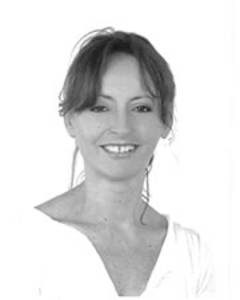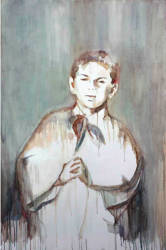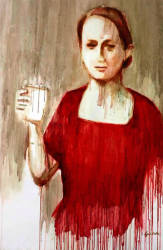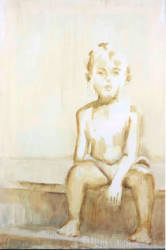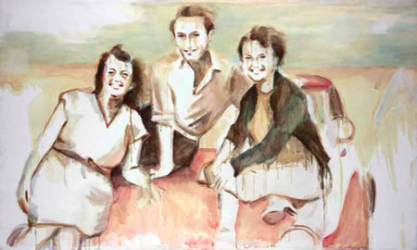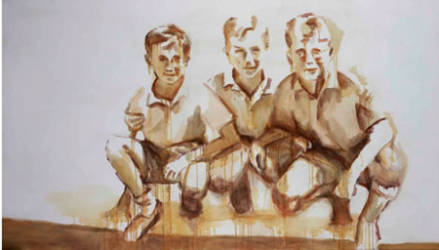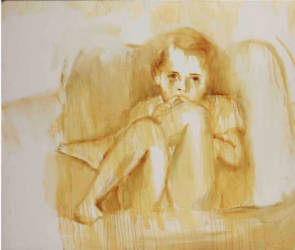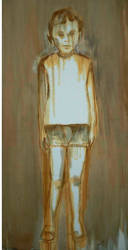www.news.egypt.com
EGYPT NEWS
THURSDAY, 25 FEBRUARY 2010
Photo album: A homage to the past in Egypt
For as long as I can remember, I was painting,” says artist Galila Nawar, whose work “Photo Album” is currently on exhibit at the Karim Francis contemporary art gallery, in the Borsa area of downtown Cairo, according to Egypt's daily newspaper al-masry al youm
A gripping nostalgia is evoked by Nawar's paintings, each an emotionally-distorted adaptation on canvas of old family pictures dating from the 1930s to the 1960s.
“A few years ago my father and grandmother passed away […] the only thing I was left with were boxes of old, sepia family pictures, which moved me beyond reason,” explains Nawar.
Originally a TV and film producer, Nawar decided to study painting and drawing at Maged el-Segini’s studio starting in 2001. In 2004 she enrolled in open courses in portraiture and oil painting at Central Saint Martins College of Art and Design in London.
“Photo Album,” her first exhibition, is a homage to characters immortalized in instantaneous snapshots, some posing awkwardly in front of the camera, others confident and smiling. Her washed, sepia portraits bear the appearance of old photographs unable to resist the repeated assaults of time and light.
“I was trained to paint real-life portraits, but when I started working on this series two years ago I deeply appreciated the distant feel of the picture, which allowed me to contemplate my emotions instead of rushing to snatch the moment,” says Nawar.
Her first painting in the “Photo Album” series, titled “Boy Alone,” depicts a young boy in short pants standing directly in front of a camera, both arms quietly resting alongside his body. The artist explains that the figure is her father. She has painted him on nearly every canvas in the exhibition.
The ochre, gray and light green Nawar uses in her paintings are the result of mixing together primary colors. Moving on to "Lilac,” a painting representing her grandmother, Nawar says that she used a light purple for her subject's dress because “it was my grandma’s favourite color, and I picture her with this lilac dress on."
In the painting, Nawar's grandmother stands in front of the photographer, smiling confidently while the pleats of her dress are softly moved by the sea breeze in Alexandria. “What convinced me to paint this picture [...] is the little handkerchief she holds in her left hand [which] reminded me so much of her,” says the artist with a vanishing smile.
Through her delicate paintings, Nawar brings back to life volatile moments of happiness and insouciance. “The Swimmer” represents her father just returning from a swim. She paints him as a young, good-looking man in a swimsuit who poses in front of the camera with a mix of boldness and vulnerability.
“The traces of dripping paint on my artwork reinforce time's distortion of memory,” Nawar says. She also deliberately decided not to finish any of the paintings, in order to convey an acute feel of passing time and vanishing memories.
In “Self-portrait,” Nawar shows just the sketch of a little girl in diapers with a concerned look on her face. The blurred contors of the young girl are brushed in a soft ochre paint. “This self-portrait epitomizes the loss of innocence,” she says.
In the piece "Buddies" nearby, a joyous band of three boys are shown crouching in the grass. The young boys are dressed in short pants and white shirts, and they sport high socks which cover their thin calves. We can instantly imagine these boys with their plump, rosy cheeks and high-pitched laughs, constantly teasing each other.
When asked about her ongoing work, the artist explains that she has not decided which of two topics--the city of Alexandria, or women--will draw her attention next. “When I was a child I used to go to my grandmother’s house for six months of every year, and I am strongly attached to these memories,” she says, "although it may be time to say goodbye to the past.”
The exhibition runs until March 31 at Karim Francis Gallery
1 el-Sherifein Street, 2nd floor, Downtown, Cairo
Saturday through Thursday 1-8 PM
+202 2391 6357
">
